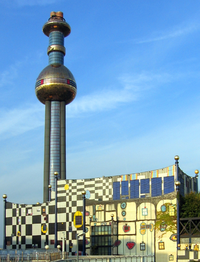
Photo from wikipedia
In this study, food waste (FW) and paper wastes were subjected to hydrothermal carbonization (HTC) with a purpose to improve energy recovery potential. FW is suggested as the suitable feedstock… Click to show full abstract
In this study, food waste (FW) and paper wastes were subjected to hydrothermal carbonization (HTC) with a purpose to improve energy recovery potential. FW is suggested as the suitable feedstock for production of hydrochar (HC) having highest calorific value (29.6 MJ/kg). Carbon content in FW derived HC was increased from 50% to ∼72% whereas energy retention efficiency was found to be 5.74 times of that in FW. Wastewater recovered after HTC of FW was rich in carbohydrates with chemical oxygen demand of ∼56,000 mg/L which may further be subjected to anaerobic treatment for biogas generation. Energy balance calculations showed that the solid and liquid fractions recovered after HTC of FW yielded highest energy output (2950 kJ/kg FW) compared to incineration (2217 kJ/kg FW), anaerobic digestion (2605 kJ/kg) and in-vessel composting. HTC process can be adopted as decentralized facility by institutions where highly moisturized wastes are generated.
Journal Title: Bioresource technology
Year Published: 2019
Link to full text (if available)
Share on Social Media: Sign Up to like & get
recommendations!